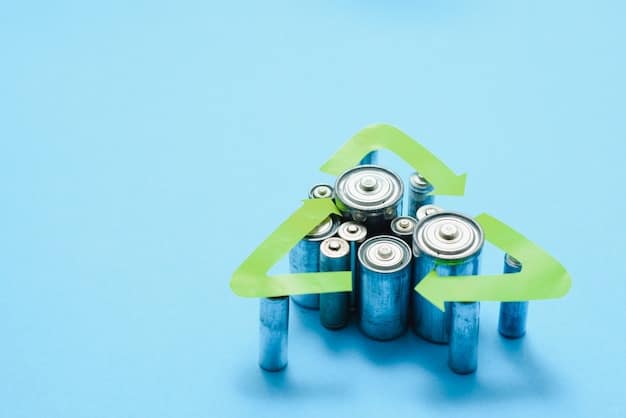The Future of US Electric Vehicles: Battery Recycling & Sustainability

The Future of Electric Vehicles in the US: How Will the New Battery Recycling Technologies Impact Environmental Sustainability? lies in innovations in electric vehicle (EV) battery technology and recycling processes that aim to mitigate environmental issues, recover valuable materials, and create a circular economy for EV batteries.
The rise of The Future of Electric Vehicles in the US: How Will the New Battery Recycling Technologies Impact Environmental Sustainability? has brought about a promising shift towards sustainable transportation. However, the environmental impact of EV batteries, particularly their disposal, is a growing concern. This article explores the cutting-edge battery recycling technologies poised to transform the EV landscape, emphasizing their potential to enhance environmental stability.
The Electric Vehicle Revolution in the US
The United States is witnessing an unprecedented surge in electric vehicle (EV) adoption. Spurred by government incentives, environmental consciousness, and technological advancements, EVs are rapidly becoming a mainstream choice for American consumers.
This transition to EVs is not merely a trend but a pivotal movement aimed at decarbonizing the transportation sector, mitigating air pollution, and combating climate change. As EV sales continue to break records, it’s crucial to understand the underlying factors driving this growth.

Government Initiatives and Incentives
Federal and state governments have implemented various policies to encourage EV adoption. Tax credits, rebates, and subsidies significantly lower the initial cost of EVs, making them more accessible to a broader range of consumers. Additionally, regulations promoting zero-emission vehicles are compelling automakers to invest heavily in EV production.
Consumer Awareness and Environmental Concerns
Growing awareness of the environmental impact of gasoline-powered vehicles is also a major driver. Consumers are increasingly seeking alternatives that reduce their carbon footprint and contribute to a cleaner environment. EVs, with their zero tailpipe emissions, offer a compelling solution for eco-conscious individuals.
- Improved Battery Technology: Advances in battery technology have led to increased range, faster charging times, and enhanced performance.
- Expanding Charging Infrastructure: The proliferation of public and private charging stations is alleviating range anxiety and making EV ownership more convenient.
- Cost Competitiveness: As battery prices decrease and EV production scales up, EVs are becoming more cost-competitive with traditional gasoline vehicles.
In conclusion, the electric vehicle revolution in the US is being fueled by a combination of supportive government policies, growing consumer environmental consciousness, technological improvements, and economic factors. As EVs continue to gain traction, the focus is shifting towards addressing the environmental challenges associated with their batteries, particularly through recycling advancements.
Environmental Impact of EV Batteries
While electric vehicles offer a cleaner alternative to traditional gasoline cars, the environmental impact of their batteries is a significant concern. EV batteries contain a mix of valuable and potentially hazardous materials, and their lifecycle—from raw material extraction to disposal—presents several environmental challenges.
Understanding these challenges is crucial for developing sustainable solutions and ensuring that the widespread adoption of EVs truly contributes to a greener future. The key environmental considerations revolve around resource depletion, manufacturing emissions, and end-of-life management.
Resource Depletion and Raw Material Extraction
The production of EV batteries requires significant amounts of raw materials such as lithium, cobalt, nickel, and manganese. The extraction of these materials can have detrimental environmental consequences, including habitat destruction, water pollution, and soil degradation. Responsible sourcing and innovative materials are essential to mitigate these impacts.
Manufacturing Emissions and Energy Consumption
The manufacturing process of EV batteries is energy-intensive and can generate substantial greenhouse gas emissions. The carbon footprint of battery production depends on the energy sources used in manufacturing facilities. Transitioning to renewable energy sources is crucial to reducing the environmental impact of battery manufacturing.

End-of-Life Management and Recycling Needs
The end-of-life management of EV batteries presents a unique set of challenges. When EV batteries reach the end of their lifespan, they must be either recycled or disposed of properly. Improper disposal can lead to soil and water contamination due to the leaching of hazardous materials.
- Toxic Materials: EV batteries contain toxic substances that can pose risks to human health and the environment if not handled correctly.
- Landfill Issues: Disposing of batteries in landfills takes up valuable space and can lead to long-term environmental contamination.
- Recycling Potential: Recycling EV batteries can recover valuable materials, reduce the need for virgin resource extraction, and minimize environmental impact.
In summary, addressing the environmental impact of EV batteries requires a comprehensive approach that encompasses responsible sourcing of raw materials, reducing manufacturing emissions, and implementing effective end-of-life management strategies. Advancements in battery recycling technologies are pivotal in achieving these goals and promoting a circular economy for EV batteries.
New Battery Recycling Technologies
To mitigate the environmental impact of EV batteries, innovative recycling technologies are being developed and refined. These technologies aim to recover valuable materials from spent batteries, reduce waste, and promote a circular economy. The advancements in battery recycling can be broadly categorized into pyrometallurgy, hydrometallurgy, and direct recycling.
Each of these methods has its advantages and challenges, and the optimal approach often depends on the battery chemistry, recycling infrastructure, and economic considerations. By understanding these different technologies, one can better appreciate the potential for sustainable EV battery management.
Pyrometallurgy: High-Temperature Processing
Pyrometallurgy involves using high temperatures to melt down battery components, separating valuable metals from other materials. This method is well-established and can handle a variety of battery chemistries without requiring extensive pre-processing. However, it is energy-intensive and may result in lower recovery rates for certain materials.
Hydrometallurgy: Chemical Leaching
Hydrometallurgy employs chemical solutions to leach out valuable metals from battery materials. This method offers higher recovery rates and can selectively extract specific metals. However, it requires complex chemical processes and can generate hazardous waste streams that need careful management.
Direct Recycling: Component Recovery
Direct recycling focuses on disassembling batteries and recovering individual components for reuse in new batteries or other applications. This method has the potential for the highest material recovery rates and the lowest environmental impact. However, it requires advanced sorting and processing technologies and may not be economically viable for all battery types.
In conclusion, new battery recycling technologies offer promising pathways to reduce the environmental impact of EV batteries. Pyrometallurgy is suitable for large-scale processing, hydrometallurgy offers high recovery rates, and direct recycling aims for maximum material reuse. The development and deployment of these technologies are crucial for creating a sustainable and circular EV battery economy.
Impact on Environmental Sustainability
The adoption of new battery recycling technologies has far-reaching implications for environmental sustainability. By recovering valuable materials from spent EV batteries, these technologies can significantly reduce the demand for virgin resource extraction, minimize waste, and lower the overall environmental footprint of electric vehicles.
These positive impacts are essential for ensuring that the transition to EVs is truly sustainable and contributes to a cleaner, healthier planet. The key areas of impact include resource conservation, reduction of pollution, and creation of a circular economy.
Resource Conservation and Reduced Mining
Recycling EV batteries helps conserve valuable resources such as lithium, cobalt, nickel, and manganese. Recovering these materials reduces the need for environmentally damaging mining activities, which can lead to habitat destruction, water pollution, and soil erosion. Utilizing recycled materials also decreases the energy required for processing virgin resources.
Reduction of Pollution and Waste
Proper recycling of EV batteries prevents the release of hazardous materials into the environment. When batteries are disposed of improperly, they can leach toxic substances into the soil and water, posing risks to human health and ecosystems. Recycling helps mitigate these risks by safely extracting and reusing valuable components.
Circular Economy for EV Batteries
The development of robust battery recycling infrastructure is crucial for establishing a circular economy for EV batteries. A circular economy aims to minimize waste and maximize the reuse of materials, reducing the overall environmental impact of products. By recycling EV batteries, valuable materials can be reintegrated into the supply chain, creating a closed-loop system.
- Extended Battery Lifespan: Recycling facilitates the recovery of high-value materials, extending the lifespan of valuable resources.
- Reduced Carbon Footprint: Using recycled materials in new batteries reduces the carbon footprint associated with raw material extraction and processing.
- Economic Benefits: Recycling creates new economic opportunities and reduces the reliance on foreign sources of raw materials.
In summary, the adoption of new battery recycling technologies is essential for achieving environmental sustainability in the EV sector. By conserving resources, reducing pollution, and promoting a circular economy, these technologies can help minimize the environmental impact of EV batteries and ensure that the transition to electric vehicles truly contributes to a greener future.
Challenges and Opportunities
While new battery recycling technologies hold immense promise for environmental sustainability, their widespread adoption faces several challenges. Addressing these challenges and seizing the opportunities they present is crucial for realizing the full potential of battery recycling in the EV sector.
The challenges range from technological and economic barriers to regulatory and logistical hurdles. However, overcoming these obstacles can unlock significant environmental and economic benefits, paving the way for a more sustainable EV industry.
Technological and Economic Barriers
The development and deployment of advanced battery recycling technologies require significant investments in research, infrastructure, and skilled labor. The economic viability of recycling processes can also be affected by fluctuations in commodity prices and the costs of waste management. Overcoming these technological and economic barriers is essential for scaling up battery recycling operations.
Regulatory and Logistical Hurdles
Clear and consistent regulations are needed to ensure the safe and environmentally responsible handling of spent EV batteries. Logistical challenges, such as the collection, transportation, and storage of batteries, can also hinder recycling efforts. Streamlining regulatory processes and improving logistical infrastructure are crucial for promoting efficient battery recycling.
Promoting Collaboration and Innovation
Collaboration among stakeholders, including automakers, battery manufacturers, recycling companies, and government agencies, is essential for driving innovation and accelerating the adoption of new battery recycling technologies. Encouraging research and development, fostering technology transfer, and promoting public-private partnerships can help overcome the challenges and capitalize on the opportunities in the battery recycling sector.
In conclusion, addressing the challenges and seizing the opportunities in the battery recycling sector requires a concerted effort from all stakeholders. By overcoming technological and economic barriers, streamlining regulatory processes, and promoting collaboration and innovation, the full potential of battery recycling can be realized, contributing to a more sustainable and circular EV industry.
Future Outlook and Policy Recommendations
The future of electric vehicle battery recycling in the US depends on continued innovation, supportive policies, and collaborative efforts. As EV adoption continues to grow, it is essential to establish a robust and sustainable battery recycling ecosystem that minimizes environmental impact and maximizes resource recovery.
This requires a long-term vision that encompasses technological advancements, regulatory frameworks, economic incentives, and public awareness. By implementing forward-looking policies and fostering innovation, the US can lead the way in sustainable EV battery management.
Promoting Research and Development
Investing in research and development is crucial for advancing battery recycling technologies and improving their economic viability. Government funding, industry partnerships, and academic collaborations can help accelerate innovation and drive the development of more efficient and environmentally friendly recycling processes. Focus areas should include improving material recovery rates, reducing energy consumption, and minimizing waste generation.
Implementing Extended Producer Responsibility (EPR)
Extended Producer Responsibility (EPR) policies hold manufacturers accountable for the end-of-life management of their products. Under EPR, automakers and battery manufacturers are responsible for collecting and recycling spent EV batteries, incentivizing them to design batteries that are easier to recycle and more environmentally friendly. EPR can help ensure that recycling costs are internalized and that manufacturers are actively engaged in promoting sustainable battery management.
Establishing Recycling Standards and Regulations
Clear and consistent recycling standards and regulations are needed to ensure the safe and environmentally responsible handling of spent EV batteries. These standards should address issues such as battery collection, transportation, storage, and processing. Regulations should also establish minimum recovery rates for valuable materials and promote the use of best available technologies for recycling.
- Incentivize Recycling: Provide tax credits, subsidies, and other incentives to encourage the development and operation of battery recycling facilities.
- Public Awareness: Launch public awareness campaigns to educate consumers and businesses about the importance of battery recycling and proper disposal methods.
- International Collaboration: Work with international partners to share best practices, coordinate recycling standards, and address global challenges related to EV battery management.
In conclusion, the future of electric vehicle battery recycling in the US hinges on proactive policies and collaborative efforts. By promoting research and development, implementing EPR, establishing recycling standards, and fostering public awareness, the US can create a sustainable battery recycling ecosystem that supports the growth of the EV industry and protects the environment for future generations.
| Key Aspect | Brief Description |
|---|---|
| ♻️ Recycling Technologies | Innovative methods to recover valuable materials from EV batteries. |
| 🌱 Environmental Impact | Reducing pollution, conserving resources, and promoting sustainability. |
| 🤝 Collaboration | Working together, automakers, recyclers, policymakers, and consumers. |
| 📜 Policy Recommendations | Regulations, incentives, and standards for sustainable battery management. |
Frequently Asked Questions (FAQ)
▼
Recycling EV batteries conserves valuable resources, reduces the need for mining, and prevents environmental pollution by safely managing hazardous materials.
▼
Pyrometallurgy uses high temperatures, hydrometallurgy employs chemical leaching, and direct recycling focuses on recovering individual battery components for reuse.
▼
Government can promote recycling through policies and regulations. Implementing Extended Producer Responsibility, establishing recycling standards, and launching public awareness campaigns.
▼
Consumers can support recycling by properly disposing of batteries at designated collection points and supporting companies involved in EV recycling initiatives.
▼
The greatest challenges in the future for EV battery recycling are technological barriers, economic viability and regulatory hurdles that need to be overcome for sustainability.
Conclusion
The convergence of electric vehicle adoption and innovative battery recycling technologies signals a transformative era for environmental sustainability in the US. As we’ve explored, the environmental challenges posed by EV batteries can be mitigated through advancements that emphasize resource conservation, pollution reduction, and the establishment of a circular economy. The path forward requires collaborative effort, supportive policies, and continued technological evolution to ensure a greener future.





